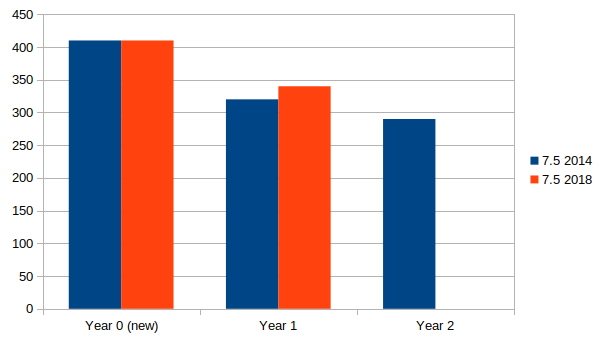I purchased a used Navajo Turbo Z 24volt electric scooter. The person I bought it from had installed two brand new 12V 7.0Ah batteries, similar to the battery in this data sheet. Note that because the scooter will discharge the batteries in less than an hour, the pack’s usable capacity is closer to 4Ah. Because the batteries are sealed lead-acid, they are heavy, approximately 6lbs each, and the pair make up approximately 35% of the scooter’s 34lb total weight. (Most of the rest of the weight comes from the hefty all-steel frame, and the 5lb 200-watt motor.)
Fully charged the battery pack measured 26.3 volts, and after a 20 minute trip (to the Marta station and back, my intended use for the scooter) the voltage read 24.5 volts. I used the charts in this article to approximately determine that this 20 minute trip reduced the charge of my batteries to 40-50 percent of their total capacity (using the “Rest” SOC line, because I measured with the scooter turned off). This would appear to indicate that I had used 3-5 Ah of capacity.
Another way to determine how much power I used is to look at the maximum power usage of the motor (either 200 or 250 watts) and the amount of time the trip took (20 minutes). 250 watts for 20 minutes is 250 * (20/60) or 83.3 watt/hours or 83.3w/24v = 3.47 Ah, which is an upper bound, although I did have the throttle fully engaged for a good part of the trip.
A third way to determine how much power was used is to measure the amount of power needed to recharge the battery: The scooter included a (very nice, switched mode) 24v battery charger. Measuring it with my Kill-A-Watt, it drew between 0 and 1 watt when idle, and 53 watts when charging the scooter. 1 Hour and 50 minutes into the charge, the charger’s indicator light went solid (indicating that it was finished with the serious charging and had moved into the float mode). When doing the final float and trickle charge the charger drew between 6-9 watts. By 2:45 the power draw had gone down to 6 watts and the entire charging run had used 0.09 Kwh (1.26 cents worth) of electricity. The batteries peaked at 27.2 volts at the end of the charging cycle and were back down to the nominal 26.4v after being off the charger for an hour. 0.09kwh is 90 watts for an hour. In a 24v battery pack, 90 watts is 90 / 24v = 3.75 Ah (including all losses to heat, etc).
A few days later I took a one-way trip (uphill) to the Marta Station, and measured the battery pack voltage level at 25.5volts after bringing the scooter home in the back of a car. Measuring the charger with the kill-a-watt, the scooter recharged in 1hr 10min and used 0.04kwh, or 1000 * 0.04 = 40 watt hours or 1.6 Ah.
If I wanted to make the electric scooter 100% solar powered I’d need a decent surface area for solar collection. For example, a pair of 4W solar panels that I’ve purchased from All Electronics measure 9.5 x 12 inches (each, or around 1.5 sq feet of area in total) and together deliver 8 watts, meaning that to deliver 3Ah at 24volts (72 Wh) would take 72Wh / 8w = 9 hours of sunlight. Atlanta only gets 5-6 hours of “full power” sunlight in a day (Perhaps 7-8 in the summer). Obviously, carting around 2-3sq ft of solar panels on a stand on scooter is not easy. (The entire scooter has about 2 sq feet of surface area, most of which the user stands on, or are side walls).


I have an electric scooter that is having issues. I must be wiring it incorrectly because as soon as the power circuit is complete, the motor runs at full throttle. Please help.
Manny,
It sounds like your throttle connection is shorted. Take a look at the throttle wiring guide I made on this page to see if it is anything like the throttle you are using:
https://www.summet.com/blog/2009/06/28/currie-technologies-6-pin-diaganostic-throttle-pin-out/
Jay
This was a very interesting and useful article on the electric “scooter”. I especially enjoyed the clear calculations and the URL for additional information. I am interested in building an electric bicycle using the motor and rechargable battery pack from a small sit-on scooter. This was very useful reading and I took notes.
THANKS.
Ray